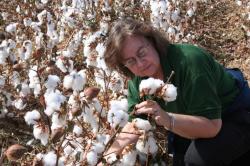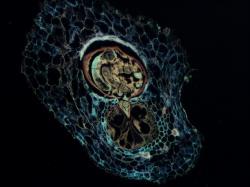Research and Special Projects
Dr. Jane Pierce

Integrated Pest Management of Insects in New Mexico Cotton, Alfalfa and Pecan
Research Assistant: Patricia Yates Monk
Our program goal is to use research to adapt, develop or discover insect pest management tactics that are most useful for New Mexico conditions. Those conditions include our desert environment and agronomic practices or varieties used in New Mexico. Our research has addressed the use of multiple methods of control with projects focusing on host plant resistance, biological controls or cultural controls in cotton, alfalfa and pecan. Current research projects include: evaluating biological control of alfalfa weevil in New Mexico; determining the impact of management practices on crop microclimate and control of insect pests in cotton and pecan; cotton yield partitioning and compensation; and variation in insect resistance in Bt cotton varieties.
Dr. David Thompson
Thompson Research Program
-
ISABEL (Insect Sensory and Behavioral Ecology Lab):
a. Collaboration with Dr. Ikju Park, who maintains and oversees a gas chromatography-mass spectrometry-electroantennodetector (GC-MS-EAD) in Watts laboratory #2 where he helps train and/or work with researchers and students interested in using the technology to answer questions in their programs.
b. The GC-MS-EAD allows for simultaneous identification of chemical compounds in volatile blends, while pinpointing which chemical compounds trigger specific behaviors in insects. Based on identified volatiles and pheromones, researchers can elucidate how/when/why insects are attracted to or repelled by specific compounds.
c. Current projects include:
-
i. Insect Pest Management efforts to improve trap function by characterizing/improving pheromone blends used in trapping and monitoring programs throughout the Southwest.
-
ii. Predicting the host range and potential non-target attacks on native plants, including threatened and endangered species, using non-destructive volatile sampling.
-
iii. Determining the importance of plant volatile organic compounds in host selection by potential and existing biological control agents of weeds, including Russian knapweed, mesquite, salt cedar, leafy spurge, thistles, and toadflax.
-
-
Host range testing for potential biological control agents:
a. Test environmental safety of potential agents in quarantine.
b. Initiate field-testing and survey for insects native to the United States that have potential as biological control agents (BCAs) with international collaborators (currently working with South Korea, South Africa, and several locations in Europe).
-
Release new biocontrol agents:
a. Determine the need and availability of BCAs for New Mexico weeds.
b. Where appropriate, potential BCAs are evaluated for safety and probable efficacy (in both the laboratory and field), necessary permits are secured from federal, state, and local agencies, and insects are acquired (collected, purchased, gifted) from available sources.
c. Sites are selected and characterized as potential insectaries for future redistribution. Insects are released and populations monitored for establishment.
-
Manage statewide insectaries and redistribute biocontrol agents on weeds:
a. Monitor populations of BCAs from insectaries around NM.
Dr. Scott Bundy

Alfalfa and Cotton Entomology
Summary: My research focus is to develop an Integrated Pest Management System for the arthropods of alfalfa and cotton in New Mexico. Primary research interests include the effects of alfalfa weevil strains on management strategies and economic injury levels, effects of established and potential methods of host plant resistance for insect management, and evaluation of other potential tools for pest management including arthropod biocontrol agents and assessments of insecticide efficacy. Secondary research interests include the ecology and taxonomy of the Heteroptera.
Current research projects include genetic analyses of alfalfa weevil strains, their distribution in the state, and implications for management; evaluation of the efficacy of okra-leaf cotton as a mechanism of host-plant resistance, and its microclimatic effects on pests and beneficials; a survey of the spiders of cotton in New Mexico and their potential impact on upland, pima, Bt, and organic cotton; pesticide bioassays for cowpea aphid in alfalfa and pink bollworm in cotton; and bionomics of Mecidea, with descriptions of immature stages.
Dr. Rebecca Creamer
Etiology and Management of Plant Diseases
The laboratory research focuses on two major areas of importance to New Mexico agriculture, plant viruses and a fungal endophyte of locoweed. We are currently characterizing the biology and epidemiology and Beet curly top virus which infects chile in New Mexico. This virus infects many crops and weed hosts throughout the western US. Research is ongoing to characterize new virus strains and viral strain variation at the molecular level, study the mechanism of transmission in the leafhopper vector of the virus, and document the role of weed hosts and vector populations in disease epidemiology.
We are also studying the role that a fungal endophyte of locoweed plays in the toxicity of this plant. We are charactering this Alternaria section Undifilum sp. that produces a toxin, swainsonine, that is poisonous to grazing animals. We are investigating the genetics of the fungus and locoweeds and comparing the genetic variability in different locoweeds and in the fungal isolates from different locoweed species. we are studying the ecological role of the fungus within its host plants. We are localizing the fungus in germinating seedings and mature plants. We are assessing the pathway of toxin biosynthesis to determine how it can be blocked without harming the plant.
Dr. Jennifer Randall

The Randall Lab is focused on the genetic and molecular mechanisms of plant development and plant microbe interactions. We work with several pathogens that include bacteria, oomycetes, and fungal species that infect plants. We also study the innate plant ‘immune’ system and how to activate the immune system to help protect plants from pathogen invasion.
- Dr. Randall's Laboratory Website
Dr. Brian Schutte
My research program’s goal is to develop efficient, effective and environmentally responsible tactics for managing agricultural weeds in New Mexico. Such tactics require knowledge on the fundamental factors contributing to weed interference in a particular agricultural system, as well as an understanding of the practical constraints that influence farmer decisions on weed management. Accordingly, my research program includes studies to clarify mechanisms of weed persistence and spread, as well as applied research projects that address the immediate weed control needs of farmers. Current areas of research include: 1) weed seedbank dynamics in irrigated cropping systems, 2) development of herbicidal and integrated management strategies for weeds in specialty crops in New Mexico, and 3) development of tools for understanding and teaching the impacts of weed seedbanks on weed control outcomes. By combining insights from basic and applied research endeavors, my research program aims to develop weed management strategies that are readily adoptable and founded on principles of plant ecology.
Dr. Steve Hanson
Molecular Biology and Biological Control of Soil-borne Fungal Diseases
My group's research is divided between two main areas, molecular biology / biotechnology and biological control of soil borne fungal diseases. Research in both areas focuses on understanding the basic biological processes involved in order to develop useful control measures that will increase the productivity of New Mexico agriculture.
Our molecular biology / biotechnology work is primarily aimed at diseases caused by viruses. Top among these is Beet Curly Top Virus (BCTV) which is one of the biggest current problems for New Mexico Chile producers today. BCTV is part of the geminivirus family, a group of viruses that cause severe damage on a number of crops throughout the world. Since there are no known sources of natural resistance for BCTV (or most other geminiviruses), my group's work is aimed at creating genetically engineered resistance to BCTV. To achieve this goal, we are currently doing a lot of basic molecular biology research to understand the fine details of how BCTV replicates at the molecular level. Other supporting work in the lab includes development of next generation molecular detection reagents and development of molecular techniques for the analysis of gene function in plants. The BCTV problem faced by Chile growers in New Mexico is a microcosm of agriculture across the world. Other geminiviruses are major constraints on the production of many crops throughout the world. Many of the worst problems are in third world countries where these viruses take a toll on subsistence level producers- people who need successful crops in order to feed their families. Ultimately, I hope that my groups work on controlling BCTV and other geminiviruses can contribute to improving the production of Chile here in New Mexico and a number of crops throughout the world.
Soil borne fungal diseases are another severe problem faced by New Mexico producers. Among these, Phytophthora capsici is a major cause of losses to New Mexico chile growers. The use of antagonistic bacterial to control diseases caused by several Phytophthora species and other fungi has been widely explored by many researchers for decades with variable success. Bacillus cereus is one bacterium that has proven effective for controlling Phytophthora caused diseased in other crops. In these other systems, the B. cereus harmlessly colonizes the plant root systems and prevents infection by fungi without harming the plant. My group is currently trying to develop B. cereus stains useful for protecting Chile from Phytophthora capsici. This work primarily involves identifying or creating new strains that are able to efficiently colonize the Chile root systems. We currently have several strains that work well under laboratory conditions. Future work on this project will involve continued optimization of strains in the lab and field testing of strains developed to date. Eventually, I hope to develop an effective biocontrol agent that can contribute to controlling soil borne diseases affecting New Mexico producers.
Dr. Steve Thomas
Plant-parasitic Nematodes Affecting New Mexico Agriculture
Additional researchers: Jacqueline Trojan, Research Specialist
General Overview:
Plant-parasitic nematodes are among the most serious pathogens of New Mexico crops. The most economically damaging nematode in the state is the southern root-knot nematode, Meloidogyne incognita. It is widely distributed and, without proper management, results in yield losses exceeding 40% in chile and 25% in cotton and most other crops. Other root-knot nematodes, including M. chitwoodi, M. partityla, and M. hapla, are much less widely distributed but pose serious threats to potato, pecan, and peanut, respectively. In addition to crop damage, the presence of some of these nematodes results in regulatory restrictions on the shipment of NM produce. Historically nematodes have been managed with pesticides, but the availability of such materials to NM producers has dwindled by 80% in recent years due to environmental concerns. As the expense of pesticide-based management has increased, so has the level of nematode damage to many crops. This program is broad in scope and endeavors to: determine how plant-parasitic nematodes interact with other pests and develop new sustainable management alternatives to pest complexes; enhance the efficacy of existing management options; educate the agricultural community regarding ways to avoid introducing new nematode pathogens; and develop protocols for identifying and managing new pest introductions. Most of our research is interdisciplinary and collaborative. Some current research projects are described below:

Nematode/weed/crop interactions:
As obligate parasites, root-knot nematodes must establish permanent feeding sites inside the roots of susceptible hosts in order to survive. This ongoing multidisciplinary project investigates the interactions among M. incognita, yellow and purple nutsedges (common perennial weeds that are alternative hosts for this nematode in NM), and locally important crops like chile, cotton and alfalfa. What we find intriguing about this association is that the pests appear to have developed mutually beneficial relationships favoring their survival in the presence of certain crops. Nutsedge tubers protect root-knot nematodes from pesticides and the environment, and emerging nutsedge plants serve as alternative food sources for the nematode. Unlike the nematode injury seen in crop plants, however, nutsedges are not damaged by nematode parasitism under agricultural conditions, but instead show increases in tuber production and tuber size, which enhances weed populations and survival in many annual cropping systems. In contrast, dense-canopied perennial crops like alfalfa, certain varieties of which possess resistance to root-knot nematodes, show promising results for use as a rotation crop to suppress this pest complex. The overall goal of this project is to develop effective, acceptable management practices that address the pest complex as a whole, since attempts to manage individual pest components have proven ineffective due to the interconnected beneficial relationships among the pests.
Pecan root-knot nematode:
A unique species of root-knot nematode, Meloidogyne partityla, which appears to only affect plants in the walnut family (pecan, walnut, and hickory), was discovered in 1996 from five pecan orchards around Texas. Shortly thereafter, we identified this nematode from mature trees in a diseased pecan orchard in New Mexico. Due to the difficulty in positively differentiating this root-knot species from other root-knot nematodes, we adapted an existing mt-DNA procedure for this purpose. Since then, we have confirmed the presence of M. partityla infested orchards in Arizona, Oklahoma, and additional locations in Texas. We have also monitored the seasonal population dynamics of this nematode on pecan for several years, and in so doing established the periods of peak nematode reproduction. There are no pesticide alternatives for management of M. partityla in pecan. Our goals with this project are to: examine the susceptibility of pecan and other perennial crops to M. partityla and other root-knot nematodes found in the state; determine the extent of pecan root-knot nematode infestation throughout NM orchards; assist in the curtailment of further dissemination of the pest; determine the potential for reducing pest severity through modification of cultural management practices. Collaborators: Mr. Brad Lewis, Entomologist.
Root-knot nematode host suitability of ornamental Southwestern plants:
Molecular identification and characterization of soil-inhabiting nematodes:
Dr. Soumaila Sanogo
Soilborne Fungal Plant Pathology/Aerobiology
Research Interests:
My research on soilborne diseases includes the following components: 1) etiology and ecology/epidemiology of soilborne pathogens; 2) soil amendments with biorational products, green manures, and crop residues for disease control; 3) disease resistance and pathogen race characterization; 4) pathogen nutrition and physiology; and 5) pathogenic interactions. The scope of my research spans a wide array of diseases including Phytophthora blight, Verticillium wilt, seedling diseases, stem rot and stem blight, anthracnose, bacterial leaf spot, bacterial wilt, fruit and pod rot, and root rot.
In addition to the work on soilborne pathogens, I am also conducting research in aerobiology, with emphasis on fungal microorganisms in dust particulate matters and rainwater. This a collaborative research aimed at assessing the quality of air in the borderland with Mexico, with collaborators from New Mexico State University and Mexico. Expected impacts in this area are the development of air quality indicators and identification of remedial measures for improving environmental quality.
Dr. Erik Lehnhoff
Weed Ecology and Management
My research focuses on discovering information to improve the management of weeds in farm and range/wildland settings. Work on the farm, in addition to testing new herbicides and adjuvants, focuses on understanding the role cover crops can play in improving weed management (Project 1). Research on invasive weeds focuses on integrated management of saltcedar (Tamarix spp.) by traditional methods and with a biological control beetle (Project 2) and developing a better understanding the drivers of Lehmann lovegrass (Eragrostis lehmanniana) invasion and how it can best be managed (Project 3).
Project 1 (with Drs. John Idowu, Nicole Pietrasiak, Soum Sanogo, Steve Thomas and Brian Schutte). Cover crops can provide numerous benefits including improving soil quality, suppressing weeds, providing nitrogen, and acting as a biofumigant after termination. However, cover crops represent additional expenses to farmers, and their values may not be immediately apparent. We aim to elucidate the benefits of cover crops and develop systems to make cover crops a profitable addition to farms. There are currently two cover crop studies underway with MS students Eric Antosh and Prashasti Agarwal. One study examines numerous cover crops and mixes including rye, mustard and hairy vetch, and all two- and three-way mixes. We are assessing the multiple effects of cover crops including their impacts on soil, weeds, disease and the microbial community. The second study focuses on the cover crops of barley, mustard and Austrian winter pea, and addresses the question of providing maximum ecosystem services while trying to minimize water use.
Project 2 (with Drs. Leslie Beck, Amy Ganguli, Brian Schutte and Carol Sutherland). Saltcedar is an invasive shrub throughout riparian areas in the western US. It is especially problematic along streams/rivers with altered flow or around reservoirs in which the water level fluctuates periodically. Management within dry reservoir bottoms is typically input heavy with herbicides or by mowing. Research by Leeland Murray (MS student) evaluates if biological control via the saltcedar beetle (Diorhabda spp.) can be integrated with conventional methods to improve management and reduce inputs.
Project 3 (with Drs. Donovan Bailey, Brandon Bestelmeyer and Nicole Pietrasiak). Lehmann lovegrass, an introduced South African grass, has invaded many grasslands and shrublands of the southwestern US, but has only recently begun to invade in New Mexico. We are working at the Jornada Basin Experimental Range to better understand the drivers of lovegrass invasion. As part of this research we are studying the potential impacts of climate change in terms of both drought and increased monsoon rainfall on lovegrass and its interactions with the native black gramma (Bouteloua eriopoda). Furthermore, we are investigating the role of soil crusts in mediating invasion and the roles of nematodes in regulating plant growth. In a separate project we are evaluating the efficacy of removing lovegrass via herbicide and restoring native grasses through the use of superabsorbent polymers (hydrogels) to capture and slowly release rainwater. Much of this research is conducted by Jackie Beacham (research technician), Sherri Buerdsell (Ph.D. student) and Andrew Dominguez (MS student).